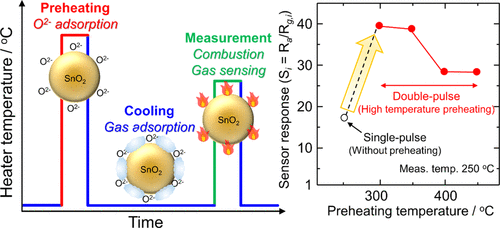Our official English website, www.x-mol.net, welcomes your
feedback! (Note: you will need to create a separate account there.)
Double-Step Modulation of Pulse-Driven Mode for High Performance SnO2 Micro Gas Sensor: Designing the Particle Surface via Rapid Preheating Process.
ACS Sensors ( IF 8.2 ) Pub Date : 2020-09-23 , DOI: 10.1021/acssensors.0c01365 Koichi Suematsu 1 , Yuki Hiroyama 2 , Wataru Harano 2 , Wataru Mizukami 3 , Ken Watanabe 1 , Kengo Shimanoe 1
ACS Sensors ( IF 8.2 ) Pub Date : 2020-09-23 , DOI: 10.1021/acssensors.0c01365 Koichi Suematsu 1 , Yuki Hiroyama 2 , Wataru Harano 2 , Wataru Mizukami 3 , Ken Watanabe 1 , Kengo Shimanoe 1
Affiliation

|
To improve the sensing properties toward volatile organic compound gases, a preheating process was introduced in a miniature pulse-driven semiconductor gas sensor, using SnO2 nanoparticles. The miniature sensor went through a short preheating span at a high temperature before being cooled and then experienced a measurement span under heating; this is the double-pulse-driven mode. This operating profile resulted in the modification of the surface conditions of naked SnO2 nanoparticles to facilitate the adsorption of O2– and ethanol-based adsorbates. Temperature-programmed reaction measurement results show that ethanol gas was adsorbed onto the SnO2 surface at 30 °C, and the adsorption amount of ethanol and its byproducts was increased after ethanol exposure at high temperatures followed by cooling. The electrical resistance of the sensor in synthetic air increased as the preheating temperature increased. The sensor responses, Si and Se, to 1 ppm ethanol at 250 °C were enhanced by introducing the preheating process; Si values at 250 °C with and without preheating at 300 °C are 40 and 15, respectively. The obtained improvements were attributed to an increase in O2– adsorption onto the SnO2 surface during the preheating phase. During the cooling phases, the adsorption of ethanol-based molecules onto the SnO2 surface and their condensation in the sensing layer contributed to the enhanced performance. In addition, the double-pulse-driven mode improves the recovery speed in the electrical resistance after gas detection. These improvements made in the sensing properties of the double-pulse-driven semiconductor gas sensors provide desirable advantages for healthcare and medical devices.
中文翻译:

高性能SnO2微型气体传感器的脉冲驱动模式的双步调制:通过快速预热过程设计粒子表面。
为了改善对挥发性有机化合物气体的感测特性,在微型脉冲驱动半导体气体传感器中使用SnO 2纳米颗粒引入了预热过程。微型传感器在冷却之前经历了短暂的高温预热时间,然后在加热下经历了测量时间。这是双脉冲驱动模式。这种运行状况导致裸露的SnO 2纳米颗粒的表面条件发生了变化,从而促进了O 2和乙醇基吸附物的吸附。程序升温反应测量结果表明,乙醇气体被吸附在SnO 2上表面在30°C时,乙醇和其副产物在高温下暴露于乙醇后冷却后,其吸附量增加。传感器在合成空气中的电阻随着预热温度的升高而增加。通过引入预热过程,可增强传感器对250 ppm时1 ppm乙醇的响应S i和S e;在250°C下(有和没有在300°C下进行预热)的S i值分别为40和15。获得的改进归因于在预热阶段O 2-在SnO 2表面上的吸附增加。在冷却阶段,乙醇基分子吸附到SnO上2表面及其在传感层中的凝结有助于提高性能。另外,双脉冲驱动模式提高了气体检测后的电阻的恢复速度。在双脉冲驱动的半导体气体传感器的感测特性方面所做的这些改进为医疗保健和医疗设备提供了理想的优势。
更新日期:2020-11-25
中文翻译:

高性能SnO2微型气体传感器的脉冲驱动模式的双步调制:通过快速预热过程设计粒子表面。
为了改善对挥发性有机化合物气体的感测特性,在微型脉冲驱动半导体气体传感器中使用SnO 2纳米颗粒引入了预热过程。微型传感器在冷却之前经历了短暂的高温预热时间,然后在加热下经历了测量时间。这是双脉冲驱动模式。这种运行状况导致裸露的SnO 2纳米颗粒的表面条件发生了变化,从而促进了O 2和乙醇基吸附物的吸附。程序升温反应测量结果表明,乙醇气体被吸附在SnO 2上表面在30°C时,乙醇和其副产物在高温下暴露于乙醇后冷却后,其吸附量增加。传感器在合成空气中的电阻随着预热温度的升高而增加。通过引入预热过程,可增强传感器对250 ppm时1 ppm乙醇的响应S i和S e;在250°C下(有和没有在300°C下进行预热)的S i值分别为40和15。获得的改进归因于在预热阶段O 2-在SnO 2表面上的吸附增加。在冷却阶段,乙醇基分子吸附到SnO上2表面及其在传感层中的凝结有助于提高性能。另外,双脉冲驱动模式提高了气体检测后的电阻的恢复速度。在双脉冲驱动的半导体气体传感器的感测特性方面所做的这些改进为医疗保健和医疗设备提供了理想的优势。











































 京公网安备 11010802027423号
京公网安备 11010802027423号